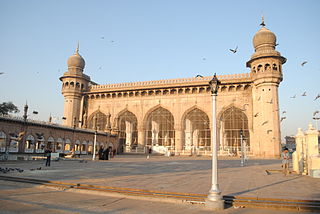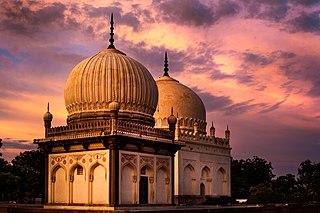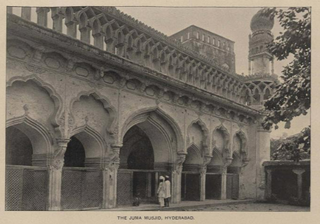
Makkah Masjid or Mecca Masjid, is a congregational mosque in Hyderabad, India. It is the largest mosque in the city, and one of the largest in the country, with a capacity of 10,000 people. The mosque was built during the 17th century, and is a state-protected monument. It serves as the primary mosque for the Old City of Hyderabad, and is located close to the historic landmarks of Charminar, Chowmahalla Palace and Laad Bazaar.

The Qutub Shahi Tombs are located in the Ibrahim Bagh, close to the famous Golconda Fort in Hyderabad, India. They contain the tombs and mosques built by the various kings of the Qutub Shahi dynasty. The galleries of the smaller tombs are of a single storey while the larger ones are two-storied. In the centre of each tomb is a sarcophagus which overlies the actual burial vault in a crypt below. The domes were originally overlaid with blue and green tiles, of which only a few pieces now remain.

The Aqmar Mosque, was built in Cairo, Egypt, as a neighborhood mosque by the Fatimid vizier al-Ma'mun al-Bata'ihi in 1125-6 CE. The mosque is situated on what was once the main avenue and ceremonial heart of Cairo, known today as al-Mu'izz Street, in the immediate neighborhood of the former Fatimid caliphal palaces. The mosque is an important monument of Fatimid architecture and of historic Cairo due to the exceptional decoration of its exterior façade and the innovative design of its floor plan.

The Mosque of Amir Altinbugha al-Maridani, dating from 1340 CE, is a mosque from the era of the Mamluk Sultanate of Cairo, Egypt. Located south of Bab Zuweila, in the Darb al-Ahmar neighbourhood, it was built on what was then the outskirts of medieval Cairo by Amir Altinbugha al-Maridani, with significant help from Sultan al-Nasir Muhammad. The mosque has a hypostyle plan similar to the Mosque of al-Nasir, and its exterior walls are decorated in typical Mamluk architecture style. At the time of its building, it was one of the most extravagantly decorated mosques in Cairo, marked by the first fully octagonal minaret and large dome, as well as other architectural innovations. Its history and luxuriousness are directly correlated to the life and prominence of al-Maridani, as it was built with the patronage of his father-in-law, the sultan, and significant donations from al-Maridani's own fortune.

The Sultan al-Ghuri Complex or Funerary complex of Sultan al-Ghuri, also known as al-Ghuriya, is a monumental Islamic religious and funerary complex built by the Mamluk sultan Qansuh al-Ghuri between 1503 and 1505 CE. The complex consists of two major buildings facing each other on al-Mu'izz li-Din Allah street, in the Fahhamin Quarter, in the middle of the historic part of Cairo, Egypt. The eastern side of the complex includes the Sultan's mausoleum, a khanqah, a sabil, and a kuttab, while the western side of the complex is a mosque and madrasa. Today the mosque-madrasa is still open as a mosque while the khanqah-mausoleum is open to visitors as a historic site.

Toli Masjid, also known as Damri Masjid, is a mosque in Hyderabad, in the Indian state of Telangana. It was constructed during the Qutb Shahi period and completed in 1671.

Char Kaman are four historical arches in Hyderabad, India. Originally demarcating an open square, they face the four cardinal directions.

Sırçalı Medrese is a 13th-century medrese in Konya, Turkey, that served as the capital of the Anatolian Seljuq state. Primary sources indicate that around twenty-four Seljuq Madrasas were built in this city. Seven madrasas still stand in Konya, preserving their architectural heritage.

The Qutbuddin Mosque, formally the Qutb al-Din Shah Mosque, is a former mosque, now in partial ruins, built in 1449 in the Old City of Ahmedabad, in the state of Gujarat, India. The structure is a Monument of National Importance. Although the mosque is not considered a distinctive building by scholars, it exemplifies the progression of the Indo-Islamic architectural style of Ahmedabad in the 15th century.

Kulsum Begum Masjid is a mosque in the Karwan locality of Hyderabad, India. It was built in the 17th century by Kulsum Begum, daughter of Sultan Muhammad Qutb Shah.

Daira Mir Momin,, is a Muslim cemetery located in the Old City of Hyderabad.

Shaikpet Mosque and Sarai is a mosque and a sarai located near Golconda in Hyderabad. It is listed as a state protected monument.
Qutb Shahi architecture is the distinct style of Indo-Islamic architecture developed during the reign of the Qutb Shahi dynasty, also known as the Golconda Sultanate.
Jama Masjid is a 505 year old Mosque in Golconda, Hyderabad, India. It was constructed in 1518 by the first Qutb Shahi ruler Sultan Quli Qutb Shah - while he was governor of the Bahmani Sultanate in current Telangana.

The Mosque of Qaytbay, also known as the Madrasa of Qaytbay, is a historic religious structure in the Qal'at al-Kabsh neighbourhood of Cairo, Egypt. Completed in 1475, it is one of multiple monuments sponsored by the Mamluk sultan al-Ashraf Qaytbay. It is not to be confused with the more famous Funerary complex of Qaytbay in the Northern Cemetery. It is described as both a madrasa and a mosque by scholars, but functions as a mosque today.

The Sultan Isa Medrese or Sultan 'Isa Madrasa, also known as the Zinciriye Medrese or Isa Bey Medresesi, is a historic landmark and former madrasa in Mardin, Turkey. It was commissioned by Sultan Isa, the penultimate Artuqid ruler of Mardin, and its construction was completed in 1385. The building was actually a külliye, or religious complex, consisting of a madrasa, a mosque, a mausoleum for the founder, and other elements arranged around two courtyards. The building previously housed the Mardin Museum.

The Jama Masjid is a mosque located in Hyderabad, in the Indian state of Telangana. It is situated to the northeast of the Charminar at a short distance, approached by a narrow lane. It was built in 1597–98, around the same time as the founding of Hyderabad, and was one of the first mosques to be built in the city.

The Mosque of Aslam al-Silahdar is a 14th-century mosque and mausoleum in the Al-Darb al-Ahmar neighbourhood of Cairo, Egypt.
Mir Muhammad Muʼmin Astarabadi was a scholar and statesman who served as the Peshwa of the Golconda Sultanate.

Saidabad Mosque is a mosque in Hyderabad.


















